
Teaching portfolio
Eric Darsow | February 2019
contents by CCAC-AFL-CIO 2017-20 contract article X.D. headers
view_array1. Academic resume
list2. Course outline
edit3. Sample assignments
code4. Sample of laboratory assignments or projects
settings5. Sample of examinations and/or written assignents
volume_up6. Summary of student survey (CCAC's SOSO results)
bar_chart7: Evidence of Professional Growth since last portfolio
border_color8: Written assessment from reviewers
school9: Information or Involvement in Assessment
group_add10: Information related to enhancing equity and diversity
public11: Service to the college and/or community
trending_up12: Statement of anticipated future professional growth
Academic resume
view_arrayEric Darsow: Resume Feb 2019
Course outline | CIT-111: Introduction to programming - Java
My courses outline are comprised of three sub-documents: the summary of standard course information, the session schedule with content URLs, and my unified grading system portal. The following set pertains to CIT-111: Introduction to programming- Java
Sample assignments
Python and Java
Data analytics
Sample of laboratory assignments or projects
Sample of examinations and/or written assignments
Evidence of Professional Growth since last portfolio
Conference posters @ the American Public Health Association 2018 Meeting
poster 1: Fusing Geospatial (GIS) Education and Youth-Led Participatory Action Research: A case study of urban youth engagement in open source mapping to address lead exposure in Lincoln-Lemington
authors:Eric Darsow, MS Information Technology, Community College of Allegheny County, Pittsburgh, PA, Denise Jones, MA, Youth Enrichment Services, Pittsburgh, PA, Marcus Poindexter, PhD Student, University of Pittsburgh, Pittsburgh, PA and Dennis Jones, PhD, West Virginia University, Morgantown, WV
official poster bay info: Slot: 3199.0 - PS-SCI: Monday, November 12, 2018: 1:00 p.m.-2:00 p.m.
abstract: Background: A community-based participatory research (CBPR) approach increases the impact of projects undertaken to address exposure of harmful lead levels. Few existing CBPR studies, however, center youth directly at each stage of the process as peer educators and interventionists. Additionally, increased reliance on computerization often involves communities surrendering control of pivotal phases of the research process to technical experts. Purpose: This study evaluates the effectiveness of a CBPR project focused on lead poisoning prevention coordinated by Youth Enrichment Services (YES), a non-profit organization in Pittsburgh. Teenage youth from the focus neighborhood became the study’s architects, data gatherers, and analysts thereby centering their critical perspectives in an adult-centric research regime. Methods: The researchers employed a peer-teaching model in mentoring a subset of the participants to use open-source digital mapping tools. These were used to analyze findings related to the communication patterns and built environment conditions present in the neighborhood as they relate to toxic lead exposure.
The students’ final products were evaluated using a four-axis scoring rubric and post-program interviews. Results: The spatial analyzer group digitized research zone maps, created a choropleth map of home age/condition, and produced a heat map of social gathering hotspots. Students who entered the program with limited exposure to data systems achieved proficiency in both the academic and technical skills to generate and share meaningful findings related to lead exposure. Conclusion: Integrating technical skills education with youth-driven CBPR adds the critical dimension of youth experience into the research process that enables community ownership of study data.
poster 2: Closing the STEM Achievement Gap with Open Source Tools: A case study examining the use of technical education and peer teaching in a youth-led community-based participatory research project
authorsEric Darsow, MS Information Technology, Community College of Allegheny County, Pittsburgh, PA, Denise Jones, MA, Youth Enrichment Services, Pittsburgh, PA, Marcus Poindexter, PhD Student, University of Pittsburgh, Pittsburgh, PA and Dennis Jones, PhD, West Virginia University, Morgantown, WV
official poster bay info: Slot: 2103.0 - PS-SCI: Sunday, November 11, 2018: 4:30 p.m.-5:30 p.m.
Abstract: Background: Public high schools in Pittsburgh struggle to implement robust STEM programs to prepare students for workforce demands in our information economy. This presentation offers a case study of a peer-teaching, field-based learning model designed to fill these gaps in technical and data-related education. Methods: Through an intensive, nine-week field research program centered around toxic lead exposure in a Pittsburgh neighborhood, researchers mentored a subset of five students participating in a larger youth research team to acquire and implement skills in research data system design and geospatial analysis. We addressed limited baseline technical skills among the student subgroup by implementing a peer-teaching model which deepened students’ knowledge and reduced disengagement behaviors common in a teacher-as-expert educational model.
Results: After a two-day rapid exposure process, students chose technical domains in which to develop mini-expertise including data importing, map feature digitization, and data instrument design. As domain experts, students then supported one another in creating their individualized digital outputs through side-by-side tutoring. As high-level facilitators only, the researchers helped to match peer-experts and peer learners strategically throughout the work cycle.Through this process, students successfully engineered a high-quality kernel density (“heat map”) map of social gathering patterns in the target neighborhood, a choropleth map depicting the age of the local housing stock, and a playground equipment exposure risk assessment. Conclusion: By harnessing and then channeling the varied interest and technical skill levels of the student cohort, peer teaching models significantly enhanced technical learning outcomes when implemented in an applied, community-oriented research context.
Curriculum design and testing
CIT-130: Object-oriented programming 1 & CIT-244: OO-2
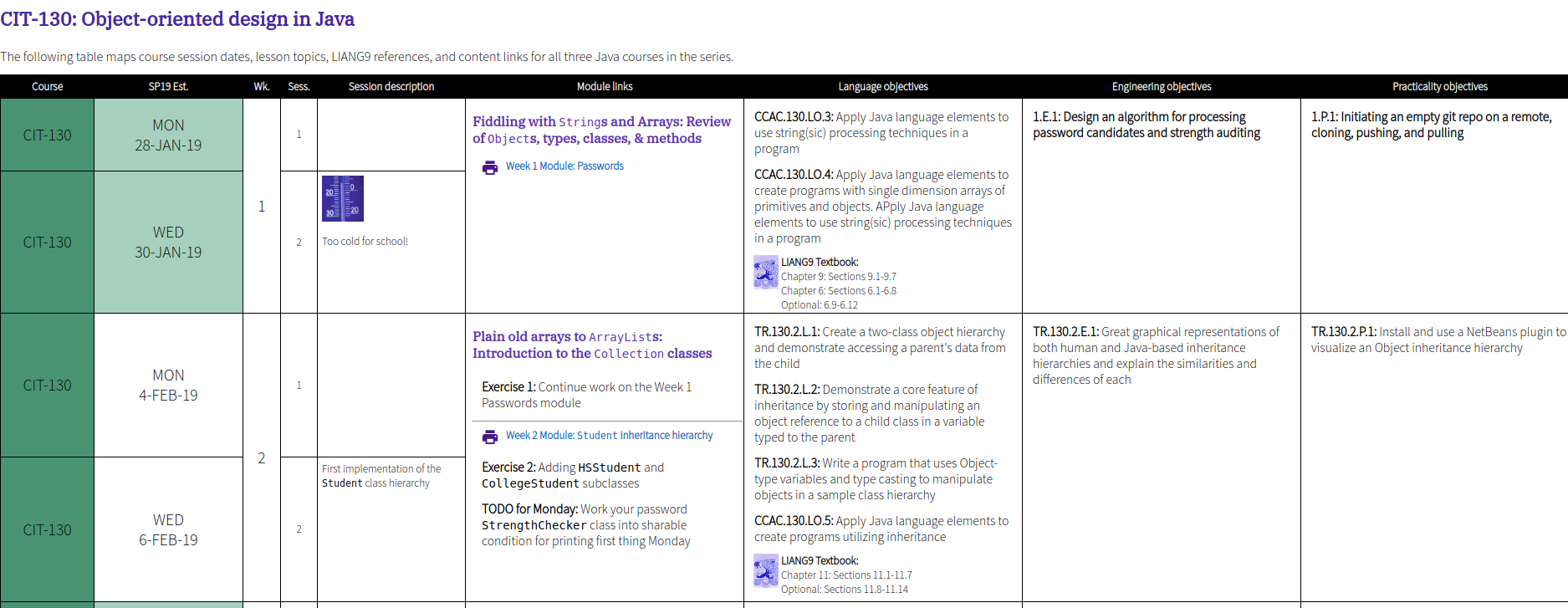
Municipal code enforcement database [MCED]
Technology Rediscovery LLC., the technology firm I created to house the development and deployment of the code enforcement web application, which now directs the productive energies of four CCAC North/West hills students. Each is learning to write software on a team, design module code, manage code with distributed version control systems (like git), and interface with clients. Further, as I engage with my contracting students, I am honing skills in project management, client relations, and team leadership which, indeed, have spillover effects into other ares of my work at CCAC.
As of February of 2019, the Municipal Code Enforcement Database [MCED] is in pre-beta testing with client governments: Pitcairn and Chalfant in the Turtle Creek Valley area. In conjunction with the Turtle Creek Valley Council of Governments and the Steel Rivers Council of Governments, the stable Beta version of the system v.0.9 will be deployed mid-year. We may potentially be administering system services for over a dozen municipalities throughout the region by the end of the calendar year.
Municipal code enforcement web application repository home page

Municipal code enforcement database [MCED]
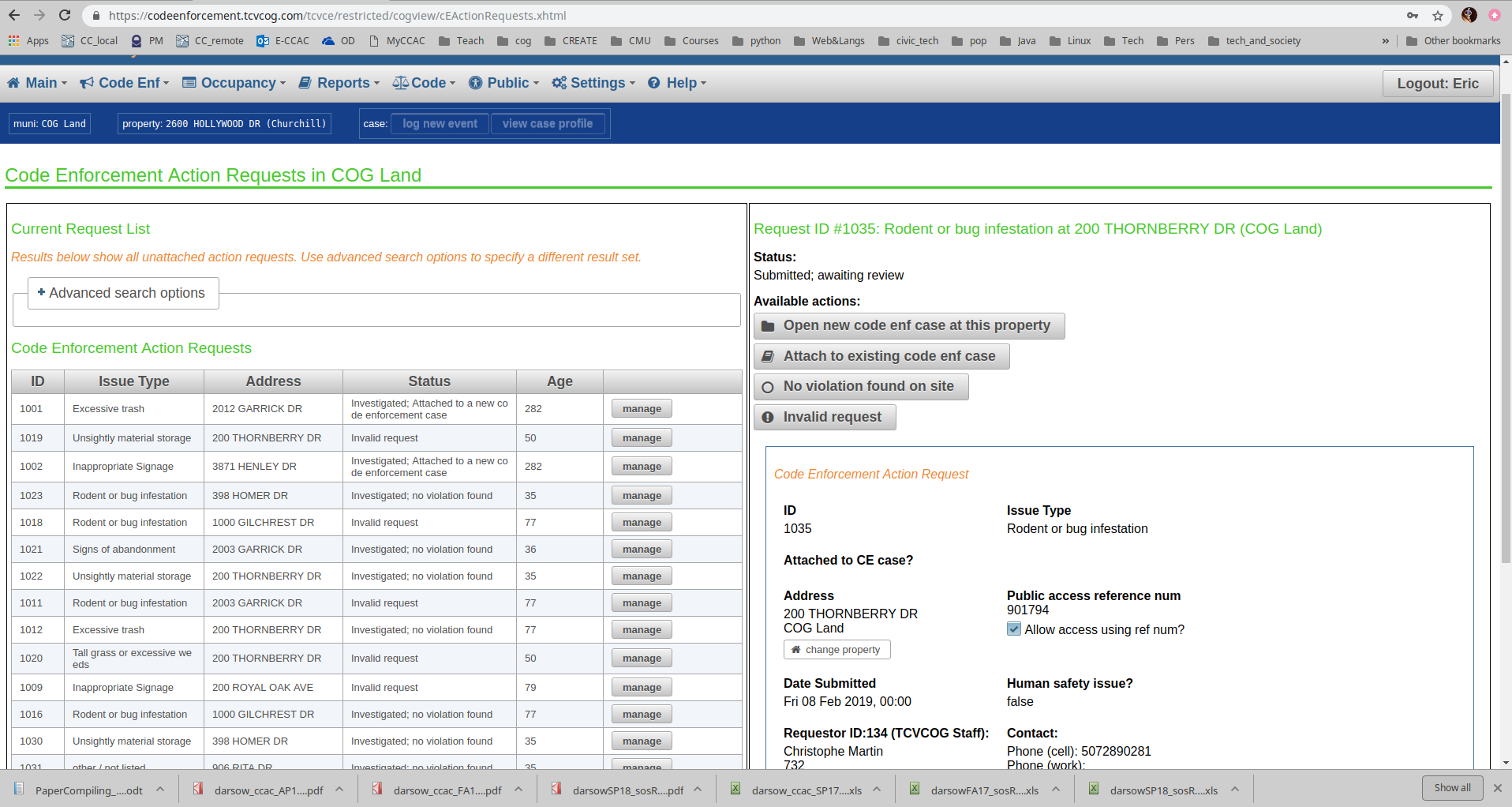
Written assessment from reviewers
As reviews of my 2019 portfolio arrive, their written feedback and my reactions will be posted here promptly.
Addressing changes requested by written reviewers
The following document displays review by Dean Jeff Thomas and my satisfaction of article X, Improvement of
2019 Reviewer: Academic Dean Jeff Thomas, CCAC North/West
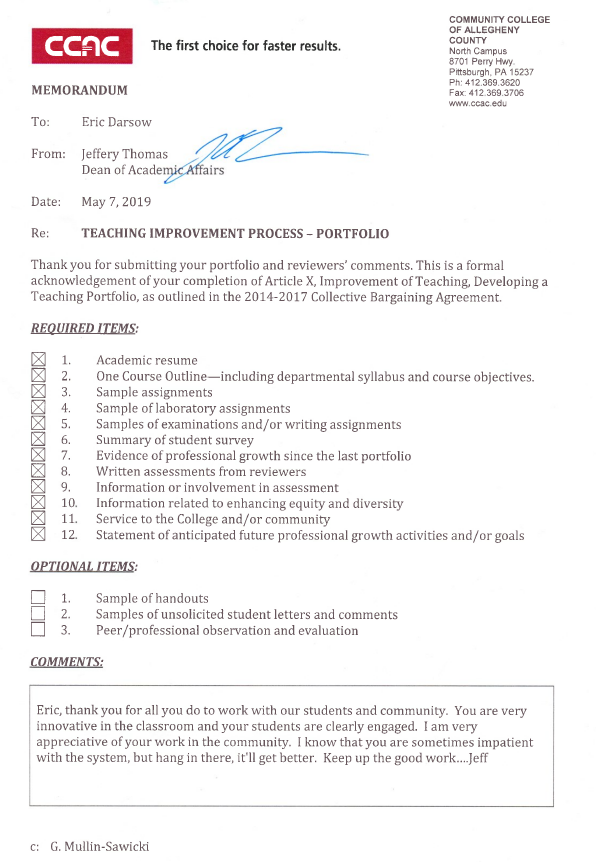
Information or Involvement in Assessment
Program assessment: Comp. Info systems 050.3
In collaboration with Professor Walter Pauli at CCAC Boyce, I created the following assessment plan and instruments for continuing our 4-year cycle of assessing our CIS transfer program. Upon review of my proposed documents, we decided to not assess this course, CIT-115 since it is an intro course and does not contain learning objectives most beneficial for assessing program strength.
Interestingly, even though we did not implement these assessment tools, these exact instruments were praised by the remote guest speaker during the CCAC All-College faculty training day in January, 2019.
Data analytics program assessment
I continue to direct, write, administer, evaluate, and implement the four-year assessment cycle for our Data Analytics program, which is currently serving its first two cohorts with an expected first graduation in Spring of 2021. The following document outlines our assessment progress including results and reactions to the latest administration of the assessment instruments.
Information related to enhancing equity and diversity
Community-oriented, field-rich data summer camp 2018 with Youth Enrichment Services 501(c)(3) and Technology Rediscovery LLC
Summer 2018: Partnering with Youth Enrichment Services (YES) based in East Liberty, Pittsburgh, I worked with eight high school/college-bound students who investigated youth-related marketing strategies of big tobacco companies during the summer of 2019.
The students participating in YES's programs often experience one or more dimensions of marginal status in context our society's hierarchical social strata. More than half of the students participating in the 2017 summer cohort hailed from high schools whose science programs are classified by YES as severely under-resourced.
Click the image box below to jump to the actual index section of technologyrediscovery.net
Summer 2018 tobacco study program link page on technologyrediscovery.net
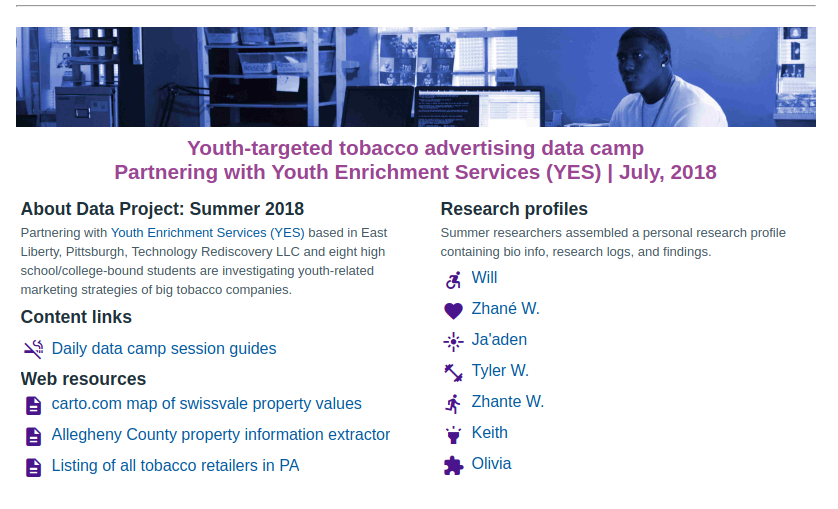
Service to the college and/or community
Learn standing up! CCAC Leadership Development Institute session facilitation, NOV-2018
Lead by Valery Keebler, the CCAC Leadership Development Institute met at CCAC North's Innovation lab to explore the concept of innovation. I led a one-hour session composed of the following sequence to build creative energy around fast-paced, multi-structured, multi-modal learning experiences:
- Participants were seated 2-3 per table, each table provided access to vertical, roving white board. Initiate process with the declaration of our central inquiry:
- What are the central differences and similarities between CCAC students and students enrolled in a traditional four-year school?
- How do these differences impact our work as educators?
- Participants began independently brainstorming a starter set of differences on a 3x5 card
- At the table level--with roving white boards nearby each--folks created a T-Chart comparison of student group characteristics that contained all the unique contributions from each member. Redundant ideas were collapsed with discussion.
- Finally, at the room level, unique ideas from each table's board were discussed briefly and transcribed to one central board.
Results:
Results: In 15 minutes we had both engaged individually and interpersonally, evaluated and compared dozens of entity characteristics (e.g. students from different types of schools in this example), and negotiated publicly differences in opinion.
Artifacts:
Figure LDI.1: Session participant comparison idea organizers
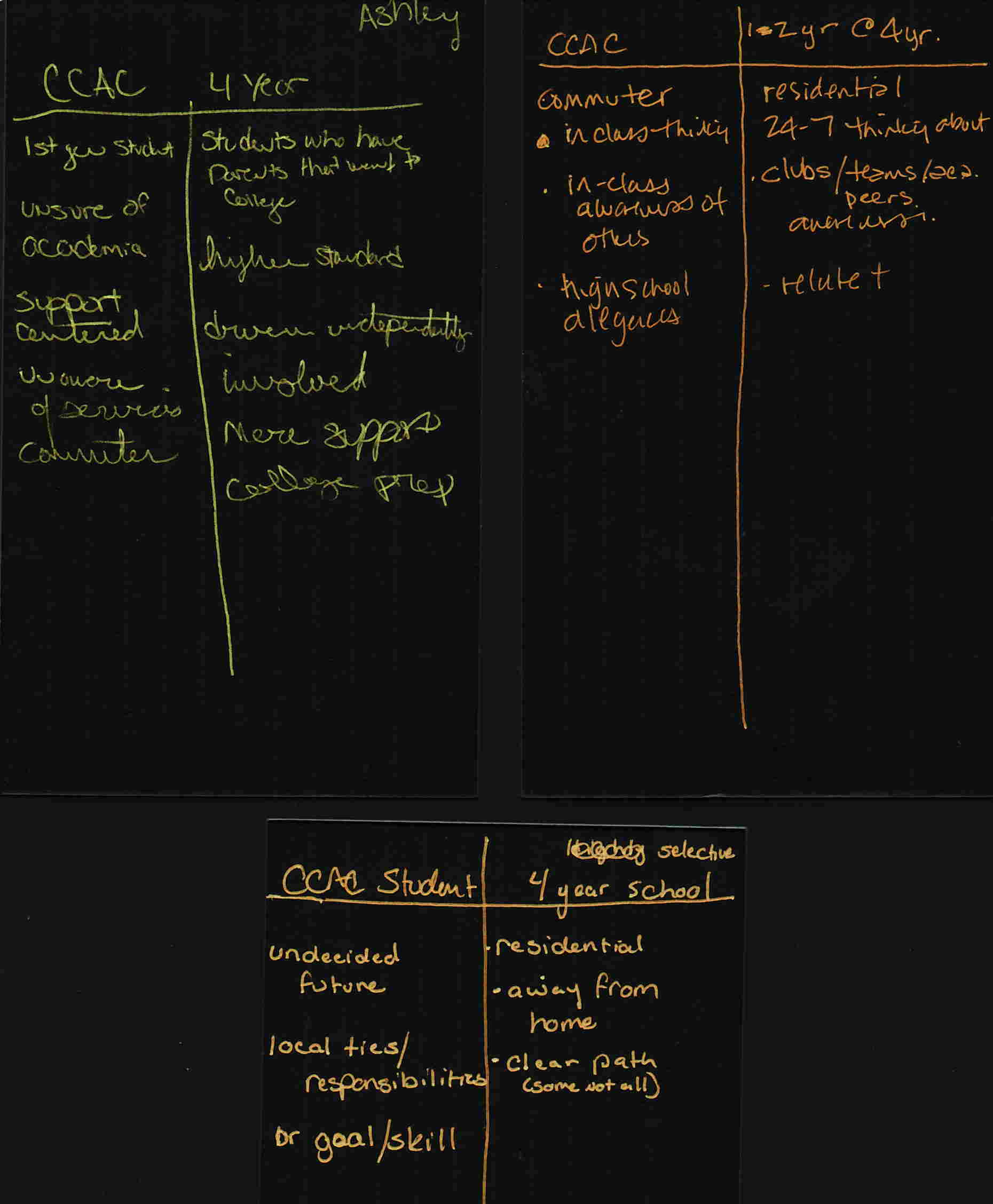
Figure LDI.2: Session participant comparison idea organizers
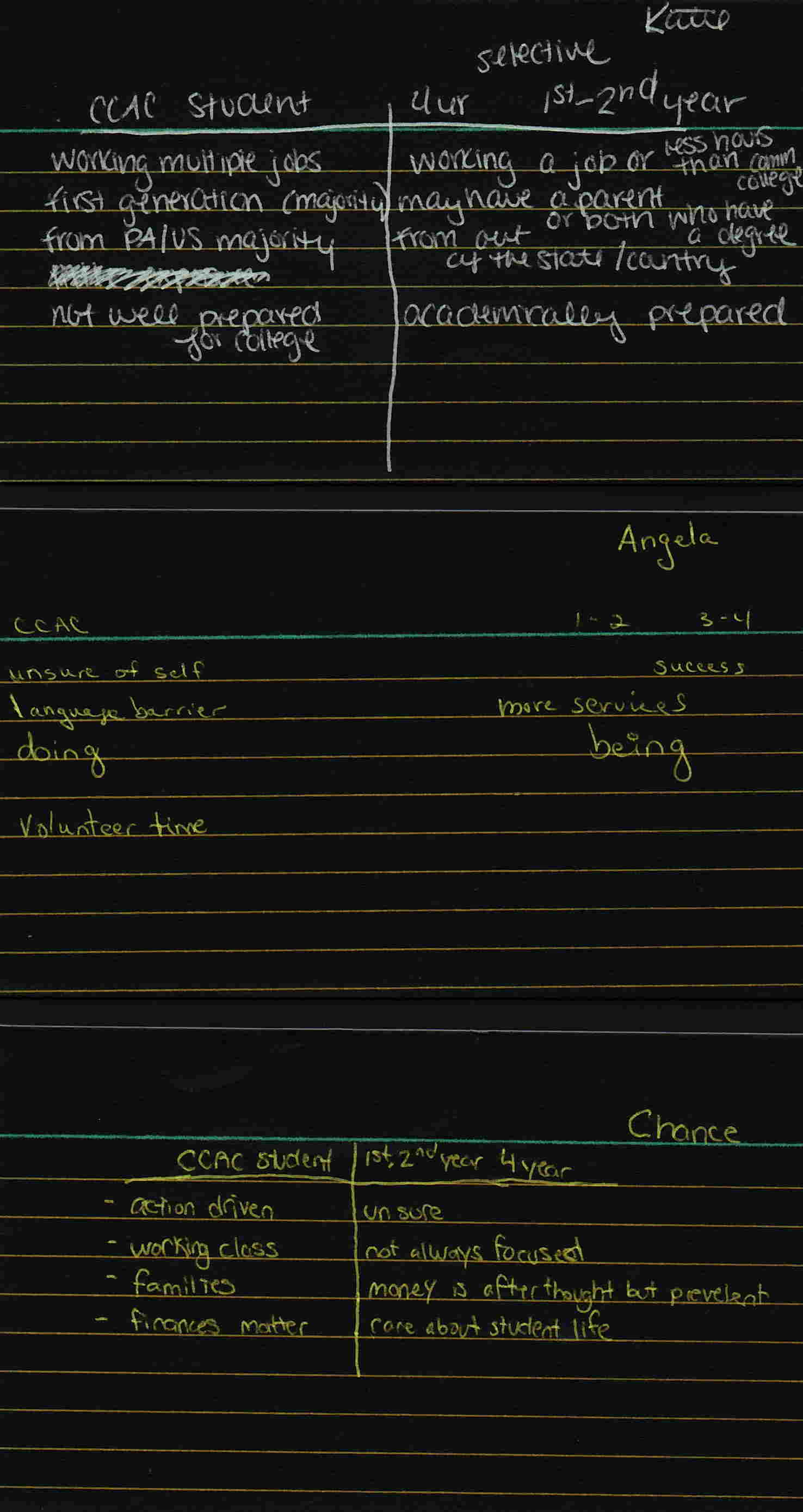
Figure LDI.3: Session participant comparison idea organizers
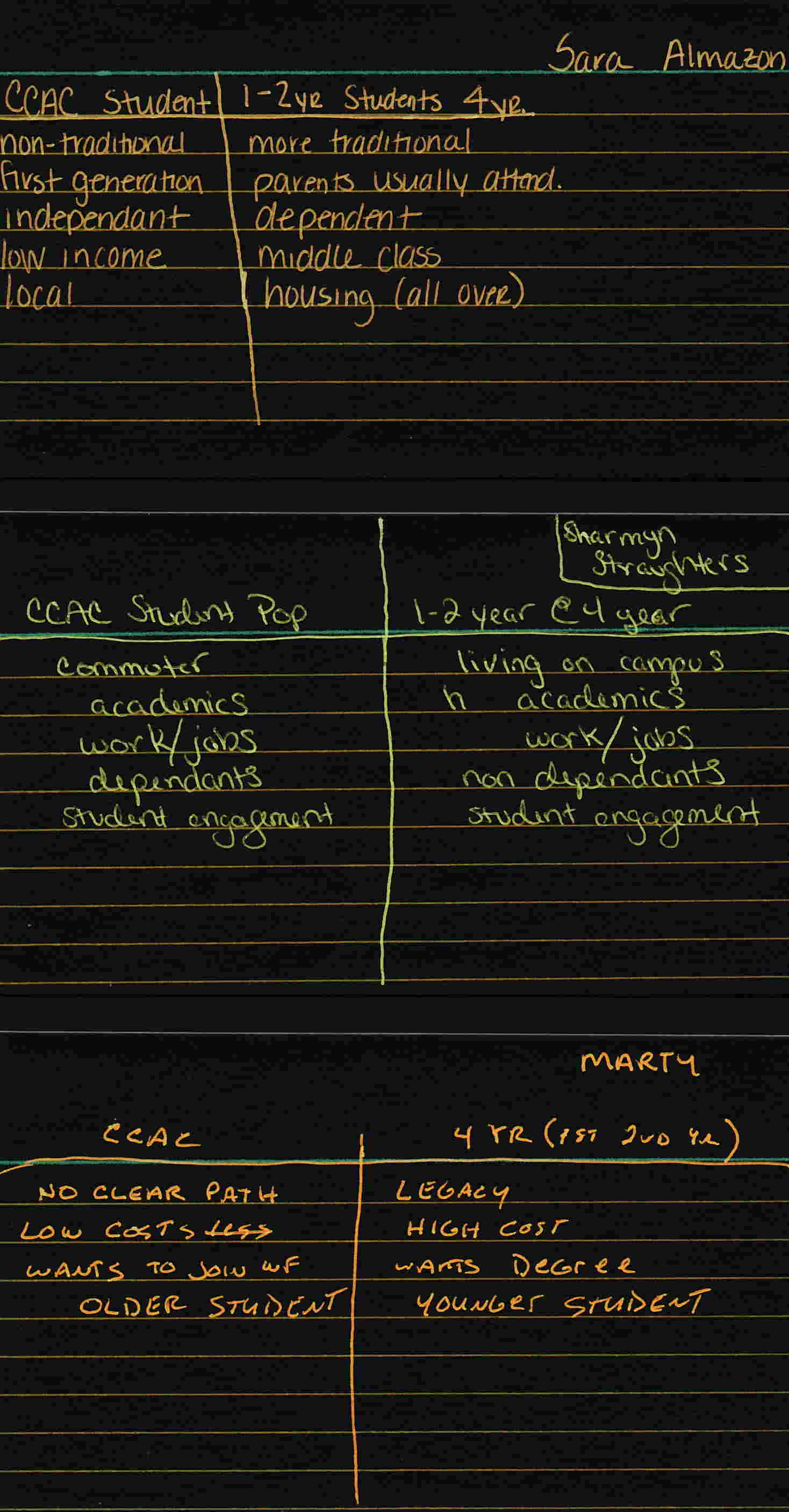
Figure LDI.4: Responses from participants
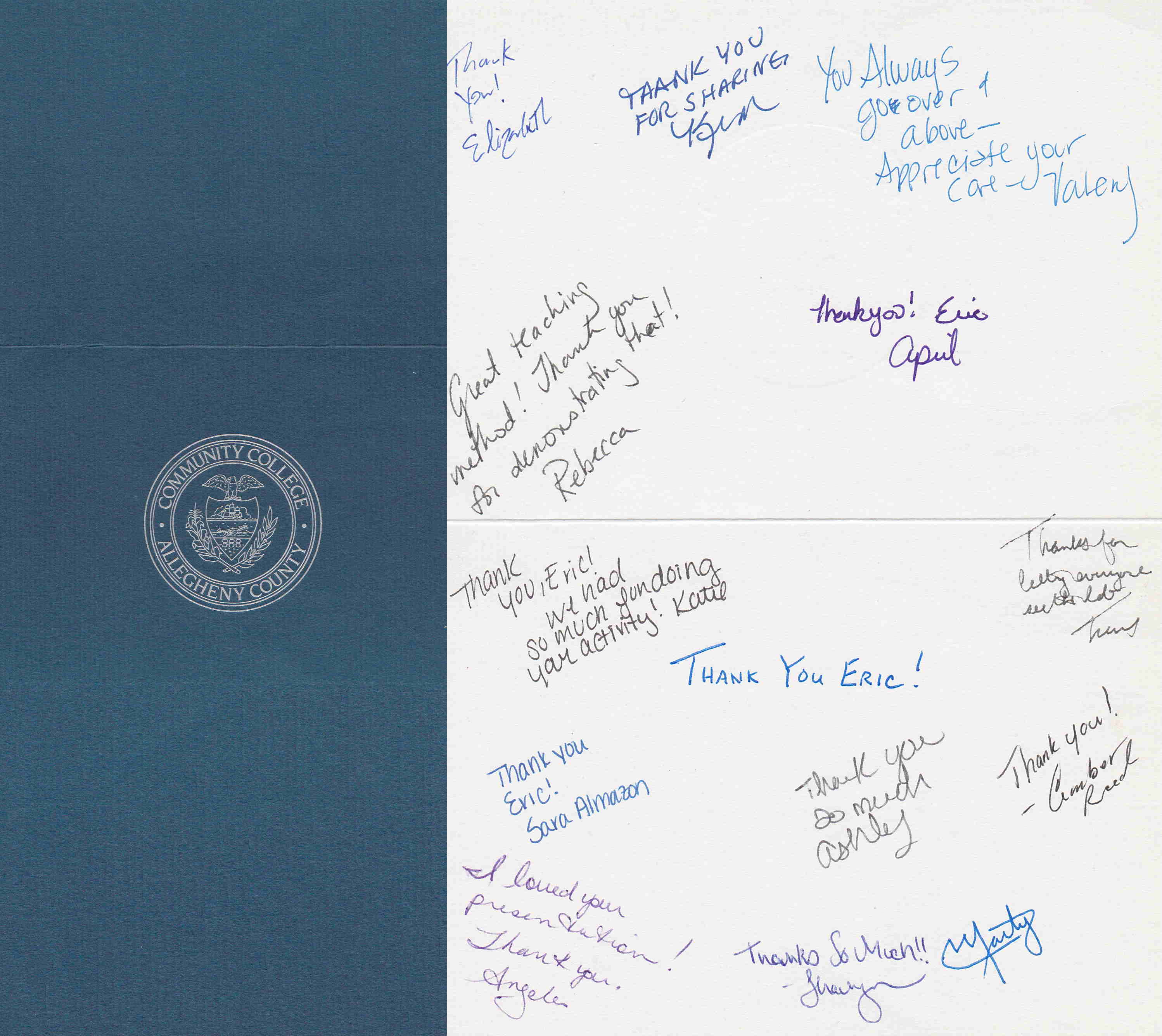
Optional 1: Sample of Handouts
Optional 2: Samples of Unsolicited Students Letters and Comments
Optional 3: Peer/professional observatiuon and evaulation
Summary of student survey &
Statement of anticipated future professional growth
Raw SOS data for terms SP17, FA17, SP18, SP19
Data-driven professional growth
The CCAC student survey feedback tool forms the basis of my professional growth plan for the upcoming year. Using an anthropologically based coding process, all student review comments were reviewed in batches from Spring 2017 through Fall 2018. I extracted eight growth areas by grouping similar course weakness listings found throughout the survey result set.
With these eight areas in place, I will be assembling growth-area-specific documentation and planning in each sub-section below. Further evaluation of my courses will seek to track the efficacy of my reactions to these student comments. Follow-up survey data will, of course, be listed as it is generated in the following sections.
Derivation of growth areas
The complete set of written Survey Of Student Opinion (SOSO) was read twice: first without any marking, with an eye for delimiting about a dozen subgroups or thematic patterns in the responses. On the second read, legible, relevant, and non-redundant responses were parsed into either growth or strength area and queued for screen clipping.
The 43 written excerpts from SOSOs administered during the four main academic terms Spring 2017 through Fall 2018 were displayed on a computer monitor using a PDF browser. Screen clippings were taken of each and the filename selection process commenced.
Filename allocation as focused coding
Assigning a filename to each clipping unfolded clip-by-clip. The screen clip software prompts for a filename immediately after taking a snip. Instead of accepting a default integer-sequence-based filename, each exerpt was categorized into an organically evolving set of growth and strength areas.
At the modest scale of responses, this informal--perhaps even crude--categorization scheme felt sufficiently organic to warrant treating the groupings as the basis of this year's portfolio reflections.

Growth area 1: Close curricular gaps
Reflections on curricular gaps and planned action steps follow the primary student data excerpts.
Excerpt G1-1

Excerpt G1-2
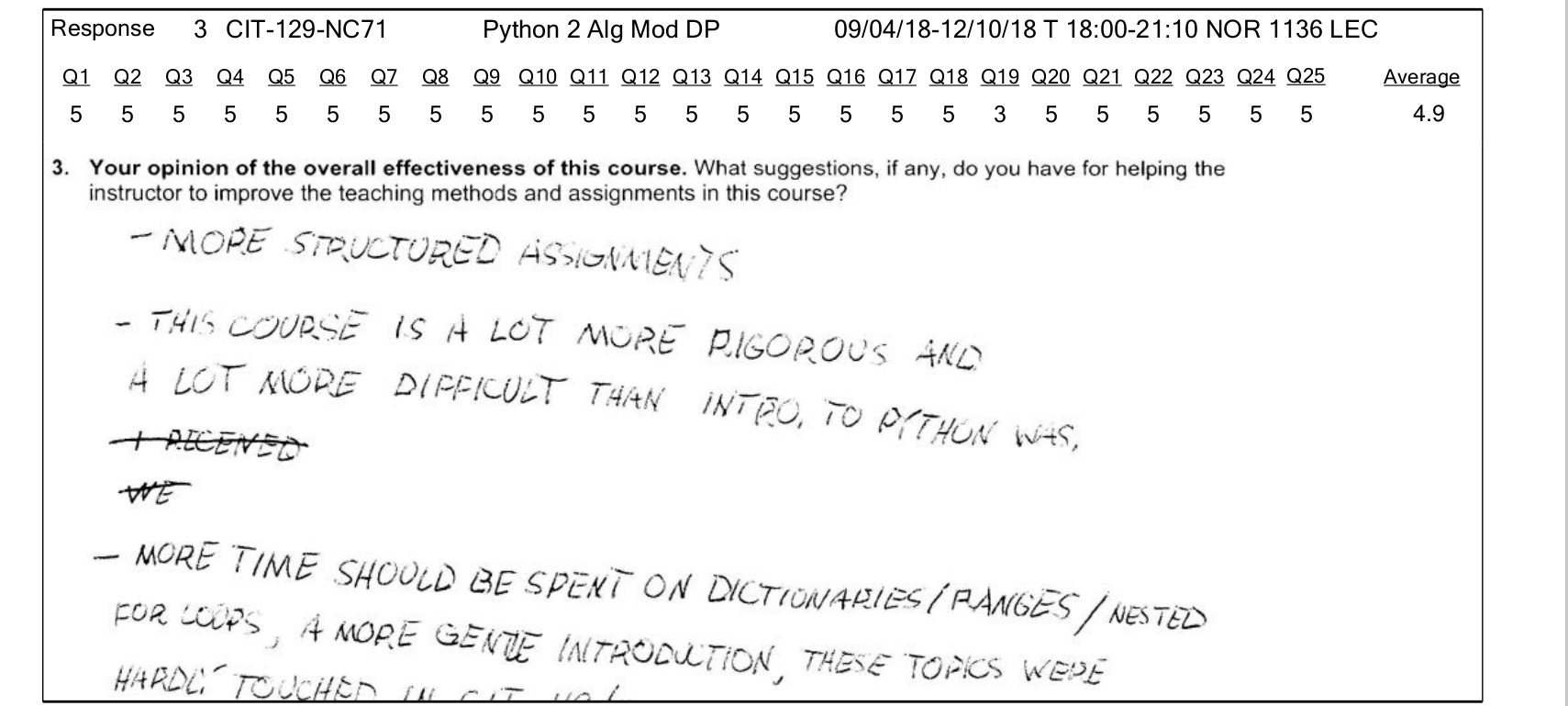
Excerpt G1-3

Excerpt G1-4
Excerpt G1-5
Excerpt G1-6
Reflections on curricular gaps
As an enthusiastic planning, nobody is more acutely aware of existing curricular gaps than I. Unfortunately, as I hope to explain, time scarcity preserves their existence.
Each moment of my class preparation time surrenders--either willingly or begrudgingly--to trade-offs between these focus ares:
- Long-term course planning: generating and organizing learning objectives relevant at the lesson or activity level
- Providing student feedback: to work submitted via the student folder system
- Lesson activity building: Writing session guides, station sets, practice sets, etc.
- Lesson embellishment: Designing compelling hooks for complex topics, creating visual aids, finding film clips
- Documentation: Recording session-specific and activity-specific notes in electronic form, scanning, cropping, posting, and annotating student work samples
During teach term from Spring 2017 through the current Spring 2019, I have endeavored to create the entire gamut of course materials (from long-term plans, project outlines, down to activity-specific worksheets and posting student work) for at least one and sometimes two or more courses.
Curricular gaps have most frequently manifest themselves in a lack of glue between major activities around core concepts. Vocabulary building, for example, should be happening prior to every major project in every unit. Less planning has occurred in these ares because my brain gravitates to 'grand schemes' that balloon to consume entire lessons, weeks, or units--squishing out less glamorous (but, indeed, foundational) core skill building time.
Action steps: strengthening the curriculum
- Choose and use a textbook for Java. Status: The Liang9 has been chosen and a class set purchased with funds from the Ida Mae and Donn D. Legacy Education Fund. Fruit is being picked already as ready-made explanations and charts of core data have already been used collectively in all three Java classes.
- Major overhaul of lesson-level objective tracking system. Status: Master sequences for each course set are in the works and about 1 week from completion.
- Inclusion of actual lesson objectives on each student handout. Status: New hamburger template includes lesson objectives in its tabular header.
- Create objective series pages for housing all core content on a topic. Status: Planned for SP19.
Growth area 2: Pacing
Excerpt G2-A: SP17

Excerpt G2-B: FA18

Excerpt G2-C: FA18

Excerpt G2-D: FA18

Excerpt G2-E: FA18
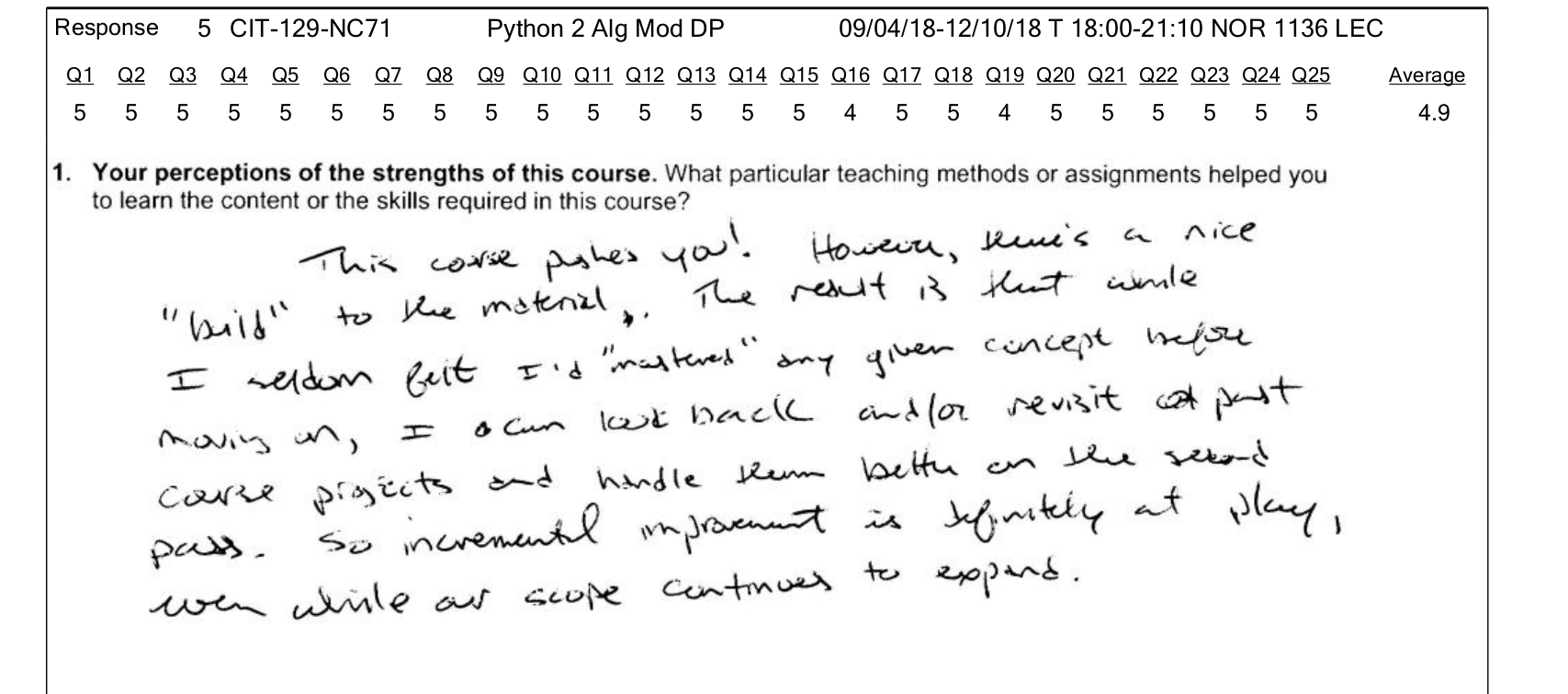
Excerpt G2-F: FA18

Growth area 3: Course organization systems
Excerpt G3-A: FA18

Excerpt G3-B: FA18 | CIT-129: Python 2

Excerpt G3-C: FA18 | CIT-129: Python 2

Excerpt G3-D: FA18 | CIT-129: Python 2

Excerpt G3-E: FA17 | CIT-115: Intro to IT

Excerpt G3: FA17 | CIT-115: Intro to IT

Growth area 4: Goal clarification
Excerpt G4: SP17

Excerpt G: FA18 | DAT-102: Intro to data analytics

Growth area 5: Out-of-class practice
Excerpt G5-A: FA18

Excerpt G5-B: FA18

Excerpt G5-C: FA18 | DAT-102: Introduction to data analytics

Excerpt G5-D: FA17

Growth area 6: Learning aids
Excerpt G6-A: FA18

Excerpt G6-B: FA17

Excerpt G6-C: FA18

Excerpt G7-D: FA17

Growth area 7: Activity-specific comments
Excerpt G7-A: FA17 | DAT-102: Intro to data analytics

Excerpt G7-B: FA17: CIT-111: Introduction to programming - Java

Growth area 8: Grading system
Excerpt G

Strength 1: Student academic growth
Excerpt S1-A: FA18
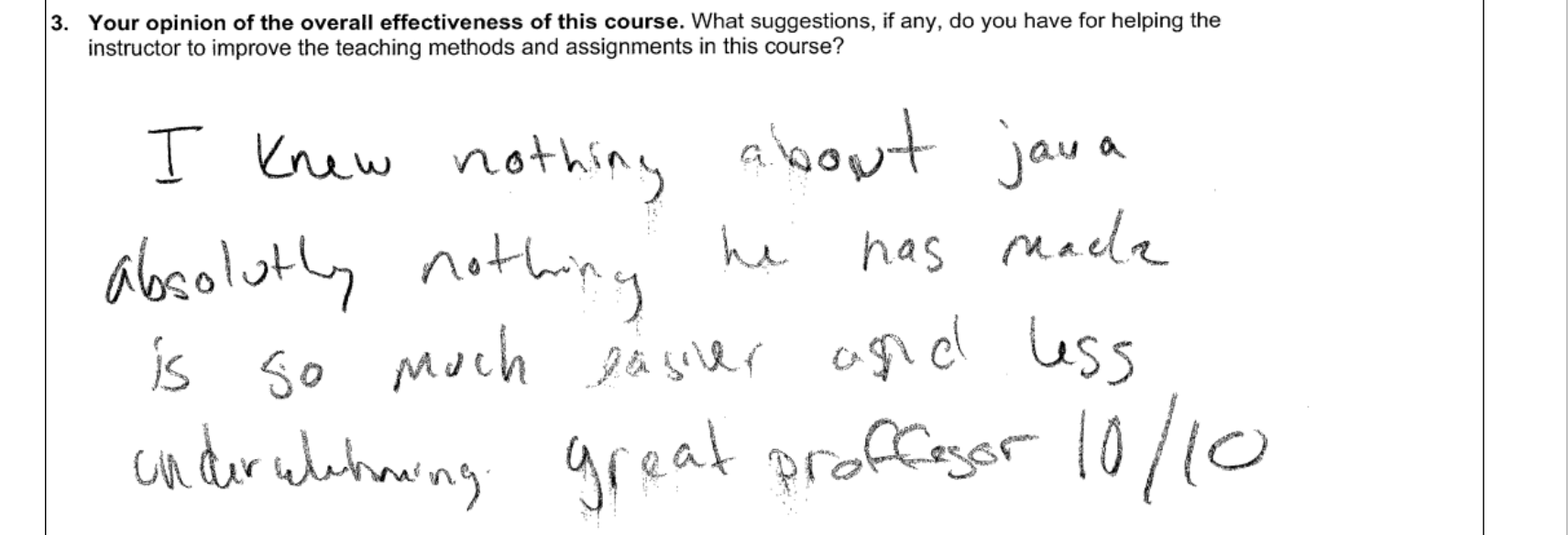
Excerpt S2-B: FA18
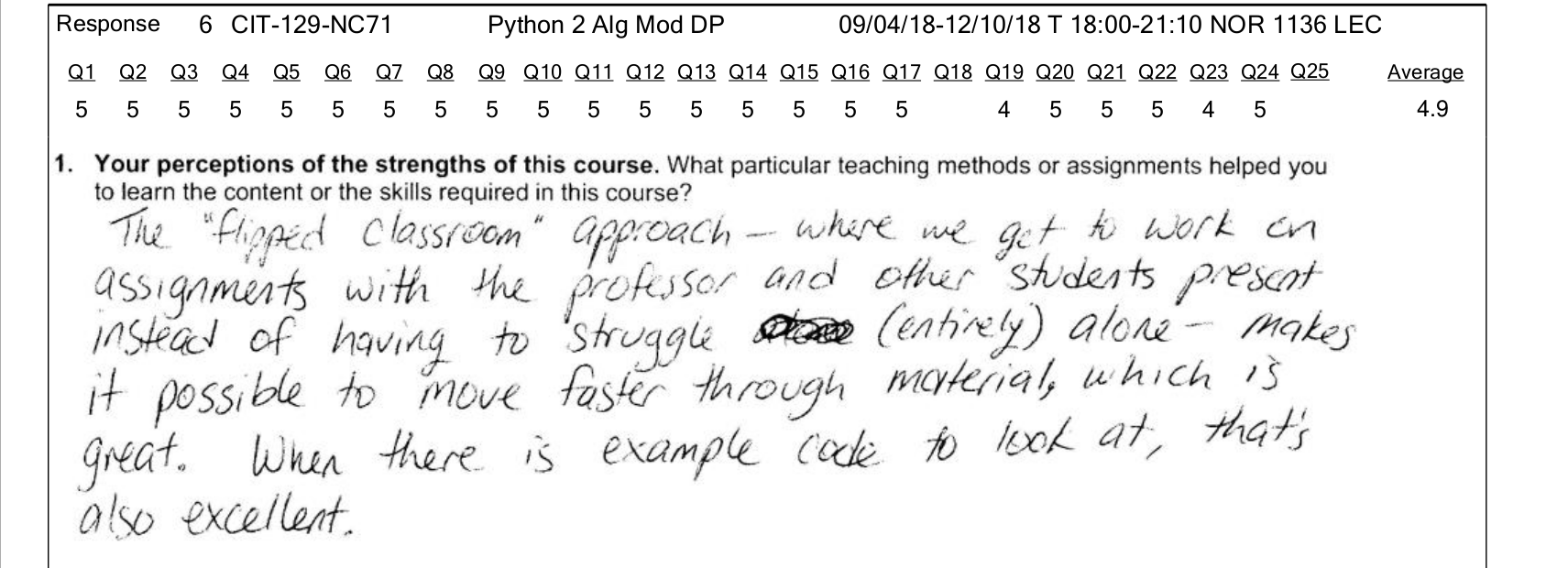
Strength 2: Original Content
Excerpt S2-A: FA18
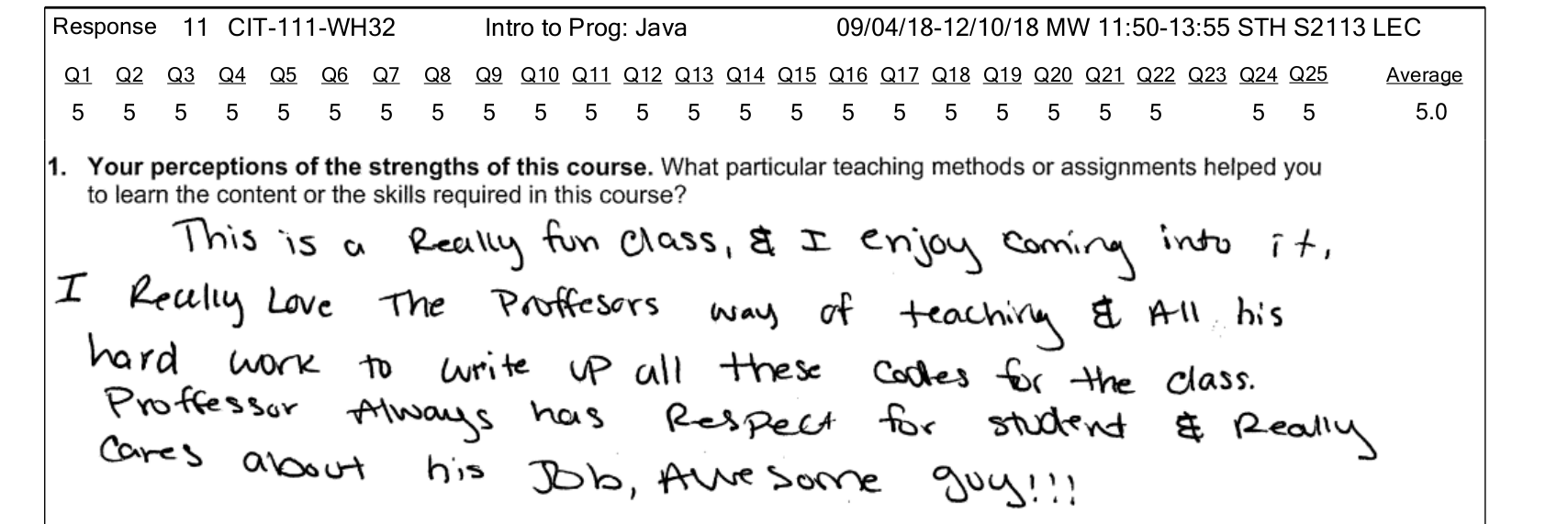
Excerpt S2-A: FA18

Excerpt S2-A: FA18

Strength 3: Multi-method teaching
Excerpt S3-A: FA18 | Data 102: Intro to data analytics

Excerpt S3-B: FA17 | CIT-111: Introduction to programming - Java
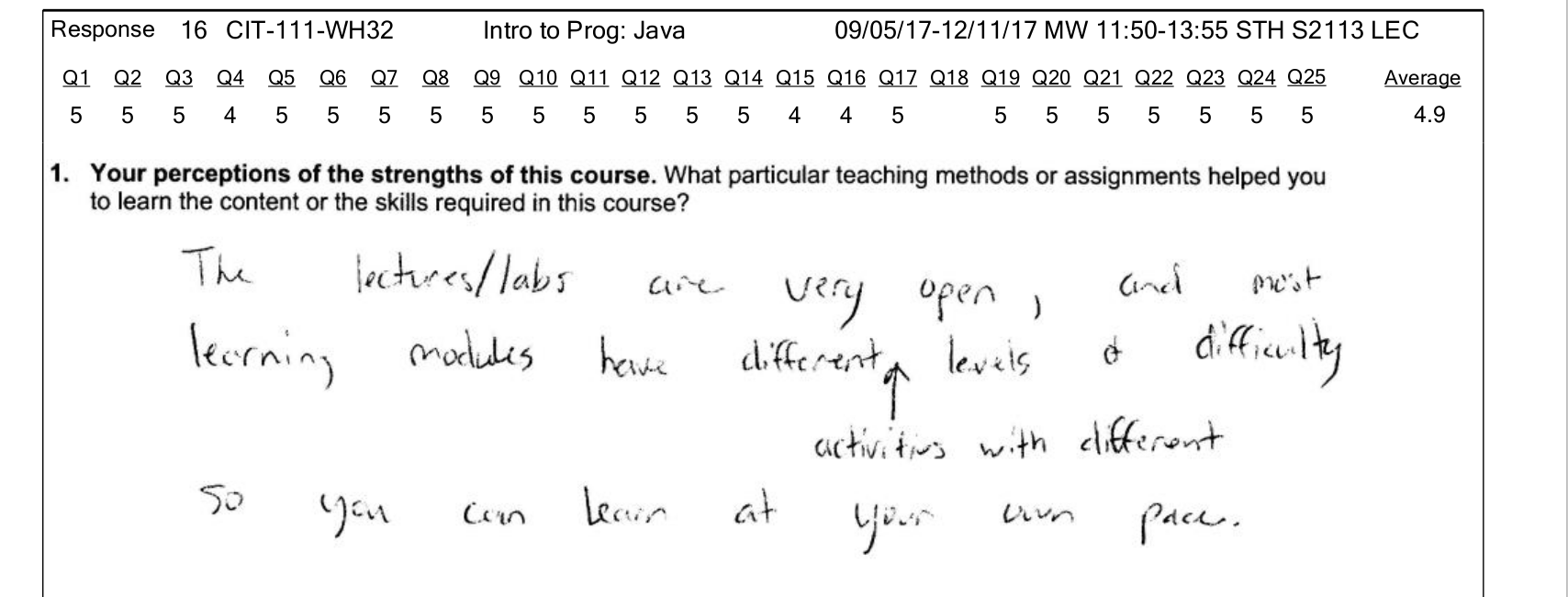
Excerpt S3-C: FA17 | CIT-111: Introduction to programming - Java

Strength 4: Responsivity
Excerpt S3-A: FA17

Excerpt S3-B: FA18
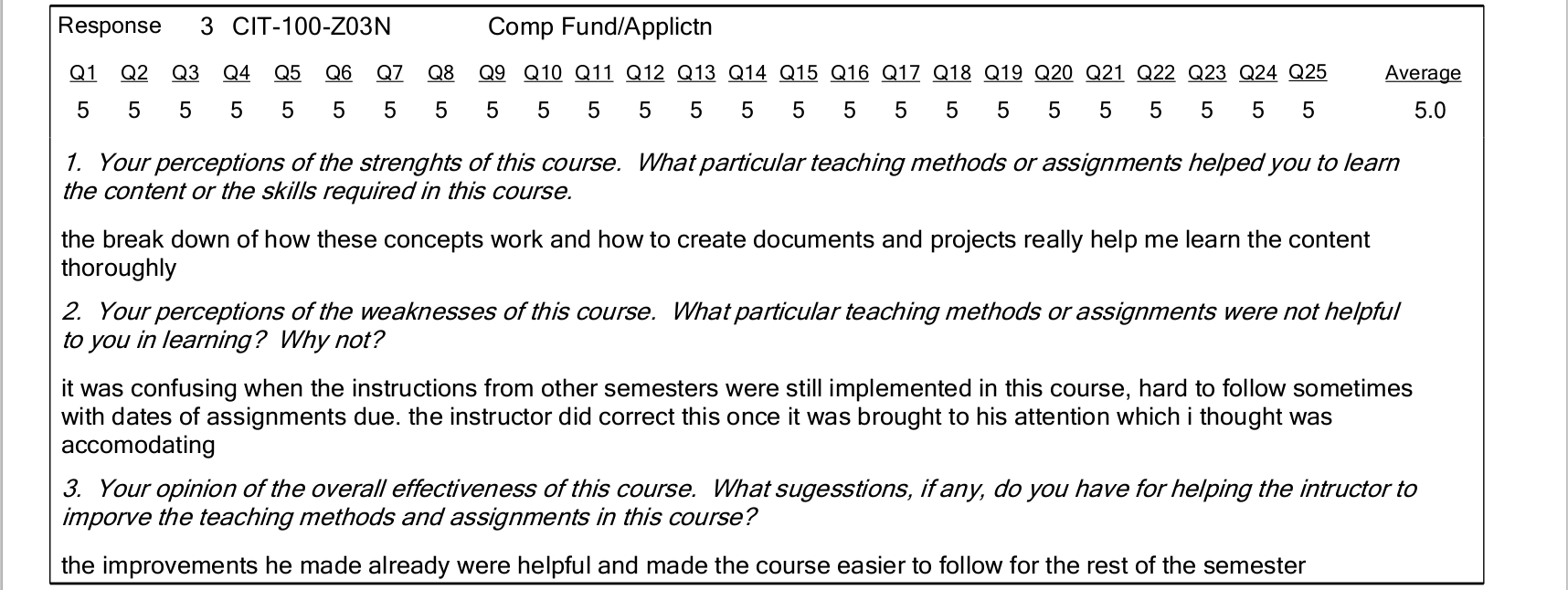
Page created in 2019 by Eric Xander Darsow and all non-linked content can be freely reproduced without any permission or attribution according to the site's content use agreement. Any links to other content is governed by each page's respective usage rights context.